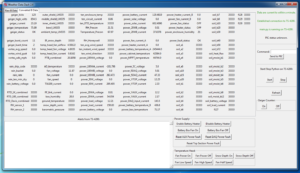Five days remaining for me, and in the ten since my last writing the GUI has grown to maturity. It displays raw and converted data (and should grow automatically when new strings and fields are added); it displays text alerts (info and error messages); it has buttons for all sorts of commands to the PIC; it refreshes every 20 seconds; it remotely starts and stops the program on Freya; it displays the freshness of the data shown and the status of Freya and the PIC. This sort of many-featured, event-driven programming is proving to tend quickly toward complexity, so I’ve rewritten the code a number of times and am pretty happy with how it stands now. It’s a GUI, after all, so here’s a picture:
Along the way I’ve been adding new features liberally to the program on Freya, which now also maintains a few files containing information for the dash to display. The documentation is also coming into being — though I don’t know what use it is, as I gather Tom and Doug mean to have me continue working on Freya as the tower grows up. Still, I might forget in the meantime how to add new fields…
The status of the project at large: Freya is ready and waiting for deployment. Tom is working on instruments — right now we’re receiving data from about 2/3 of the bottom section (the top is not yet started), though not all of those 2/3 are sending real data, I think. Paul has a better version of the website debugged and is now doing mysterious database-side things. We (Paul and I) have cleared the eventual location of the tower of foliage, and Tom is figuring out the radio link that will connect the tower to the outside world. I’ve been doing some fine-tuning of the scheduling, and have brought the drift of Freya’s cycles down from +1.2 ms/cycle on average to 0 ms/cycle last time I measured, which may be important for the integrity of Freya’s communications with the GUI and PIC, but not very important.

